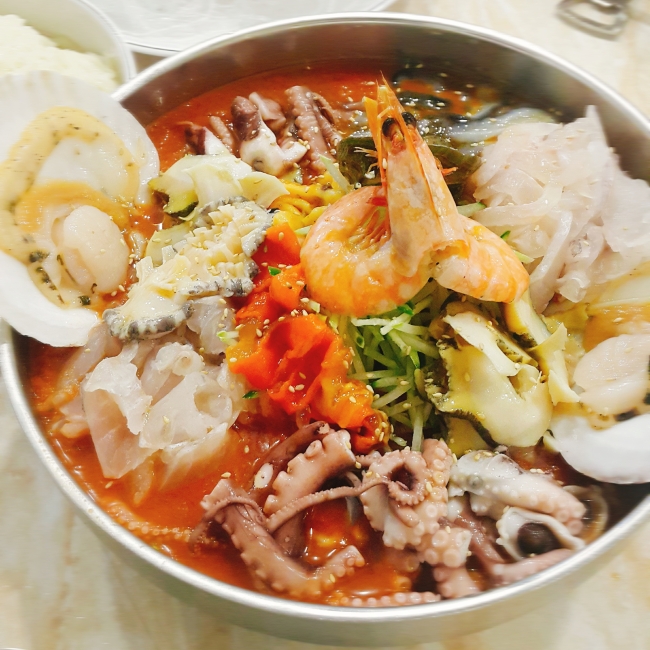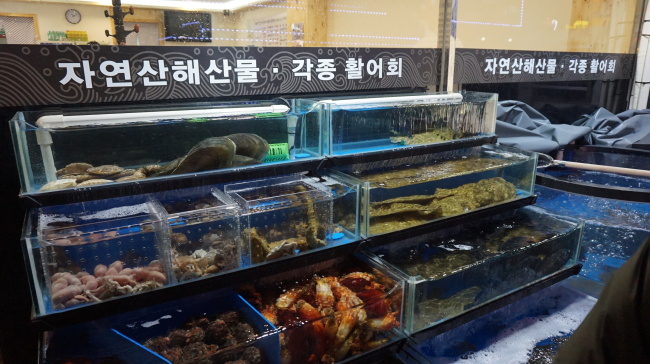In Korea the winter months are known to be the best time to enjoy seafood from the surrounding cold waters. However, it is in the summer when the bounty of the sea and fish “hoe” are the most desired.
Fresh catches from the ocean served chilled take on many forms in Korean cuisine and become the perfect match to the warm summer season. Cool on the palate and easy on the appetite, local seafood glorifies summer eating as it should be enjoyed, and one dish that is best in-season is the raw seafood soup, mulhoe.
A medley of “seafood in water” or rather an icy bath of red pepper broth, mulhoe is a robust and spicy dish that epitomizes what summer eating is all about. Best described as a marrying of both a ceviche and gazpacho, mulhoe consists of the freshest of seafood in a bright and refreshing soup.
 |
Bucheon hoe restaurant, Chungnyeon Soosan's nine seafood mulhoe with special recipe (Christine Cho) |
Originating from the southeastern coast of Korea in the Gyeongbuk region, this fisherman’s concoction comes from humble beginnings. A soup with quick and easy preparation that does not require heat, it was an accessible meal for the busy sea weary and sometimes hungover fisherman.
The dish originally consisted of merely thinly sliced fresh caught fish mixed in with water, red pepper paste, and often soju. But the dish has evolved and refined itself and is now enjoyed all over Korea with different well-known renditions found in Pohang and on Jejudo Island.
In the summer, hanchi mulhoe is a popular dish on Jejudo Island, taking full advantage of this optimal seasonal specialty. Young and tender local hanchi mitra squid is cut into thin slivers and enjoyed in Jeju’s signature spicy doenjang version. A bit earthier in taste from the addition of doenjang and tangier from the vinegar, Jeju mulhoe is unique on its own and usually served with only one type of fish or seafood such as sea cucumber, abalone, turban shell, or damselfish.
 |
Fresh seafood tanks at Chungnyeon Soosan in Bucheon, Gyeonggi Province (Christine Cho) |
In Pohang, where mulhoe was created, the well-seasoned red pepper paste gochujang is what differentiates one mulhoe from one’s neighbors. Fresh live fish, so readily available, is also imperative to the Pohang mulhoe and an ample of amount of broth is usually included to finish this version with the traditional addition of rice or noodles.
For Seoulites who yearn for the coast and fresh seafood but can’t make the trek to Jeju or Pohang, in nearby Bucheon the charming hoe restaurant Chungnyeon Soosan serves a delightful version of mulhoe. With more than nine types of seafood and a chef’s secret recipe, one can try raw seafood soup loaded with lots of flavor and personal in-house touches.
Places to enjoy mulhoe:
Chungnyeon Soosan
Address:
31-17, Sohyang-ro 37 beon-gil
Wonmi-gu, Bucheon-si, Gyeonggi-do
Phone 032-326-8737
Sambo Sikdang
Address:
319-8 Seogwi-dong
Seogwipo-si, Jeju
Telephone: 064-762-3620
By Christine Cho (
thepalatekorea@gmail.com)
Christine Cho, a Korean-American expat in Seoul, has been eating and cooking her way around the world for 16 years as a private chef. -- Ed.





![[Herald Interview] 'Trump will use tariffs as first line of defense for American manufacturing'](http://res.heraldm.com/phpwas/restmb_idxmake.php?idx=644&simg=/content/image/2024/11/26/20241126050017_0.jpg)


![[Health and care] Getting cancer young: Why cancer isn’t just an older person’s battle](http://res.heraldm.com/phpwas/restmb_idxmake.php?idx=644&simg=/content/image/2024/11/26/20241126050043_0.jpg)
